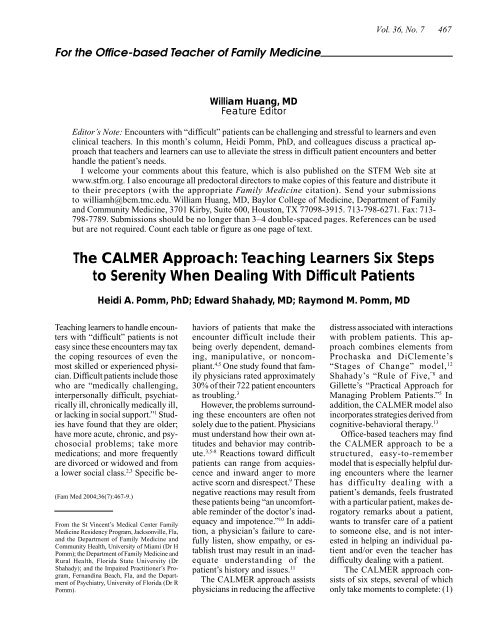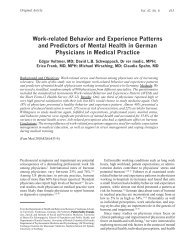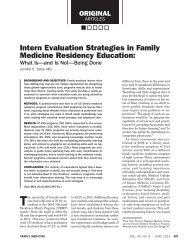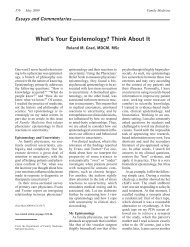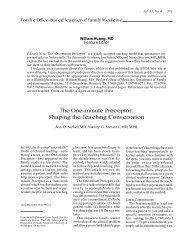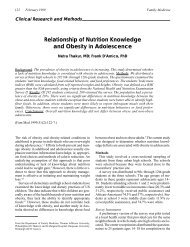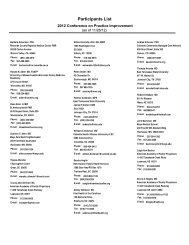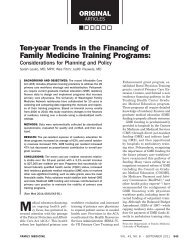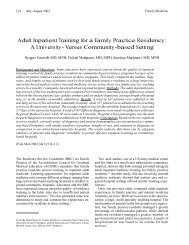The CALMER Approach: Teaching Learners Six Steps to ... - STFM
The CALMER Approach: Teaching Learners Six Steps to ... - STFM
The CALMER Approach: Teaching Learners Six Steps to ... - STFM
Create successful ePaper yourself
Turn your PDF publications into a flip-book with our unique Google optimized e-Paper software.
For the Office-based Teacher of Family Medicine<br />
William Huang, MD<br />
Feature Edi<strong>to</strong>r<br />
Vol. 36, No. 7<br />
Edi<strong>to</strong>r’s Note: Encounters with “difficult” patients can be challenging and stressful <strong>to</strong> learners and even<br />
clinical teachers. In this month’s column, Heidi Pomm, PhD, and colleagues discuss a practical approach<br />
that teachers and learners can use <strong>to</strong> alleviate the stress in difficult patient encounters and better<br />
handle the patient’s needs.<br />
I welcome your comments about this feature, which is also published on the <strong>STFM</strong> Web site at<br />
www.stfm.org. I also encourage all predoc<strong>to</strong>ral direc<strong>to</strong>rs <strong>to</strong> make copies of this feature and distribute it<br />
<strong>to</strong> their precep<strong>to</strong>rs (with the appropriate Family Medicine citation). Send your submissions<br />
<strong>to</strong> williamh@bcm.tmc.edu. William Huang, MD, Baylor College of Medicine, Department of Family<br />
and Community Medicine, 3701 Kirby, Suite 600, Hous<strong>to</strong>n, TX 77098-3915. 713-798-6271. Fax: 713-<br />
798-7789. Submissions should be no longer than 3–4 double-spaced pages. References can be used<br />
but are not required. Count each table or figure as one page of text.<br />
<strong>The</strong> <strong>CALMER</strong> <strong>Approach</strong>: <strong>Teaching</strong> <strong>Learners</strong> <strong>Six</strong> <strong>Steps</strong><br />
<strong>to</strong> Serenity When Dealing With Difficult Patients<br />
<strong>Teaching</strong> learners <strong>to</strong> handle encounters<br />
with “difficult” patients is not<br />
easy since these encounters may tax<br />
the coping resources of even the<br />
most skilled or experienced physician.<br />
Difficult patients include those<br />
who are “medically challenging,<br />
interpersonally difficult, psychiatrically<br />
ill, chronically medically ill,<br />
or lacking in social support.” 1 Studies<br />
have found that they are older;<br />
have more acute, chronic, and psychosocial<br />
problems; take more<br />
medications; and more frequently<br />
are divorced or widowed and from<br />
a lower social class. 2,3 Specific be-<br />
(Fam Med 2004;36(7):467-9.)<br />
Heidi A. Pomm, PhD; Edward Shahady, MD; Raymond M. Pomm, MD<br />
From the St Vincent’s Medical Center Family<br />
Medicine Residency Program, Jacksonville, Fla,<br />
and the Department of Family Medicine and<br />
Community Health, University of Miami (Dr H<br />
Pomm); the Department of Family Medicine and<br />
Rural Health, Florida State University (Dr<br />
Shahady); and the Impaired Practitioner’s Program,<br />
Fernandina Beach, Fla, and the Department<br />
of Psychiatry, University of Florida (Dr R<br />
Pomm).<br />
haviors of patients that make the<br />
encounter difficult include their<br />
being overly dependent, demanding,<br />
manipulative, or noncompliant.<br />
4,5 One study found that family<br />
physicians rated approximately<br />
30% of their 722 patient encounters<br />
as troubling. 3<br />
However, the problems surrounding<br />
these encounters are often not<br />
solely due <strong>to</strong> the patient. Physicians<br />
must understand how their own attitudes<br />
and behavior may contribute.<br />
3,5-8 Reactions <strong>to</strong>ward difficult<br />
patients can range from acquiescence<br />
and inward anger <strong>to</strong> more<br />
active scorn and disrespect. 9 <strong>The</strong>se<br />
negative reactions may result from<br />
these patients being “an uncomfortable<br />
reminder of the doc<strong>to</strong>r’s inadequacy<br />
and impotence.” 10 In addition,<br />
a physician’s failure <strong>to</strong> carefully<br />
listen, show empathy, or establish<br />
trust may result in an inadequate<br />
understanding of the<br />
patient’s his<strong>to</strong>ry and issues. 11<br />
<strong>The</strong> <strong>CALMER</strong> approach assists<br />
physicians in reducing the affective<br />
467<br />
distress associated with interactions<br />
with problem patients. This approach<br />
combines elements from<br />
Prochaska and DiClemente’s<br />
“Stages of Change” model, 12<br />
Shahady’s “Rule of Five, ”8 and<br />
Gillette’s “Practical <strong>Approach</strong> for<br />
Managing Problem Patients.” 5 In<br />
addition, the <strong>CALMER</strong> model also<br />
incorporates strategies derived from<br />
cognitive-behavioral therapy. 13<br />
Office-based teachers may find<br />
the <strong>CALMER</strong> approach <strong>to</strong> be a<br />
structured, easy-<strong>to</strong>-remember<br />
model that is especially helpful during<br />
encounters where the learner<br />
has difficulty dealing with a<br />
patient’s demands, feels frustrated<br />
with a particular patient, makes deroga<strong>to</strong>ry<br />
remarks about a patient,<br />
wants <strong>to</strong> transfer care of a patient<br />
<strong>to</strong> someone else, and is not interested<br />
in helping an individual patient<br />
and/or even the teacher has<br />
difficulty dealing with a patient.<br />
<strong>The</strong> <strong>CALMER</strong> approach consists<br />
of six steps, several of which<br />
only take moments <strong>to</strong> complete: (1)
468 July-August 2004 Family Medicine<br />
Catalyst for change, (2) Alter<br />
thoughts <strong>to</strong> change feelings, (3)<br />
Listen and then make a diagnosis,<br />
(4) Make an agreement, (5) Education<br />
and follow-up, and (6) Reach<br />
out and discuss feelings.<br />
(1) Catalyst for Change<br />
In this step (either before, during,<br />
or after an interaction with a difficult<br />
patient), physicians should remind<br />
themselves of what they can<br />
and cannot control about the situation.<br />
In most cases, the responsibility<br />
<strong>to</strong> change behavior lies with the<br />
patient. Physicians cannot control<br />
the patient’s behavior, but they can<br />
control their own reaction and try<br />
<strong>to</strong> be helpful by offering practical<br />
advice. After identifying the<br />
patient’s current stage in the “Stages<br />
of Change” model, 12 (Table 1) the<br />
physician can serve as a catalyst for<br />
change by giving recommendations<br />
on how the patient can advance <strong>to</strong><br />
the next stage of change and eventually<br />
overcome the problem.<br />
(2) Alter Thoughts<br />
<strong>to</strong> Change Feelings<br />
Cognitive-behavioral therapy<br />
posits that the only way individuals<br />
can control their reactions (feelings)<br />
is <strong>to</strong> alter their thoughts about<br />
the situation. 13 Either before, during,<br />
or after the doc<strong>to</strong>r-patient interaction,<br />
physicians should identify<br />
which feelings they are experiencing<br />
in response <strong>to</strong> the patient and<br />
then ask how these feelings might<br />
be affecting the physician-patient<br />
relationship and the management<br />
plan. Physicians should remind<br />
themselves not <strong>to</strong> take the patient’s<br />
behavior personally, since this is<br />
likely the patient’s way of responding<br />
and behaving in many areas of<br />
his/her life (not just in interactions<br />
with the physician). It is also suggested<br />
that the physician explore<br />
and understand possible underlying<br />
reasons or answers for the patient’s<br />
behavior (past abuse, poor finances,<br />
loneliness, etc). Lastly, physicians<br />
should ask themselves, “What can<br />
I tell myself about this situation that<br />
will make me feel less (angry, dis-<br />
gusted, etc)?” In doing so, they are<br />
then able <strong>to</strong> alter or change their<br />
thoughts and therefore feel less distressed.<br />
(3) Listen and <strong>The</strong>n<br />
Make a Diagnosis<br />
As a result of a physician’s negative<br />
response <strong>to</strong> a difficult patient<br />
encounter, he/she may not accurately<br />
hear what the patient is trying<br />
<strong>to</strong> verbally or nonverbally communicate.<br />
11 This can lead <strong>to</strong> severe<br />
errors in diagnosis. By engaging in<br />
the first two steps described above,<br />
the physician will be better<br />
equipped <strong>to</strong> truly hear what patients<br />
are trying <strong>to</strong> communicate. This<br />
will improve the likelihood of making<br />
more-accurate diagnoses and<br />
will lead <strong>to</strong> better working relationships<br />
with patients.<br />
(4) Make an Agreement<br />
This step is focused solely on<br />
making an agreement with the patient<br />
<strong>to</strong> continue the doc<strong>to</strong>r-patient<br />
relationship. <strong>The</strong> physician might<br />
say <strong>to</strong> the patient, “So, after all we<br />
have discussed, it is my understanding<br />
that you would like <strong>to</strong> continue<br />
<strong>to</strong> see me, and we have agreed that<br />
we will work <strong>to</strong>gether <strong>to</strong> keep you<br />
as healthy as possible. Is that your<br />
understanding <strong>to</strong>o?” It is important<br />
<strong>to</strong> confirm that the patient understands<br />
and agrees with the proposal.<br />
Table 1<br />
Stages of Change<br />
• Precontemplation Patient denies or minimizes problem<br />
• Contemplation Patient acknowledges problem but not ready <strong>to</strong> change<br />
• Preparation/determination Patient commits <strong>to</strong> time and plan for resolving the problem<br />
• Action Patient makes daily efforts <strong>to</strong> overcome problem<br />
• Maintenance Patient has overcome problem for at least 6 months<br />
but must remain vigilant<br />
• Relapse Patient has gone back <strong>to</strong> problem behavior<br />
Adapted from Prochaska JO, DiClemente CC. <strong>The</strong> transtheoretical approach: crossing traditional<br />
boundaries of therapy. Homewood, Ill: Dow-Jones-Irwin, 1984. 12<br />
In addition, if the patient has insight<br />
in<strong>to</strong> the problem behavior, the physician<br />
might say, “We have agreed<br />
<strong>to</strong> work on this problem (specify<br />
exactly what the problem is) <strong>to</strong>gether.<br />
Is that your understanding<br />
as well?” This step helps both the<br />
physician and the patient increase<br />
their awareness that they are making<br />
a conscious choice <strong>to</strong> continue<br />
their relationship and work on the<br />
patient’s concerns, which in turn<br />
increases perceived control for both<br />
parties.<br />
(5) Education and Follow-up<br />
After the doc<strong>to</strong>r and the patient<br />
agree <strong>to</strong> continue their relationship<br />
and work <strong>to</strong>gether, how they will<br />
accomplish this needs <strong>to</strong> be addressed<br />
as specifically as possible.<br />
Physicians should temporarily let<br />
go of their own agenda (even<br />
though they feel it is more appropriate)<br />
and give a “doable” recommendation<br />
tailored <strong>to</strong> where the<br />
patient is in the “Stages of Change”<br />
model. 12 For example, for a patient<br />
contemplating whether <strong>to</strong> quit<br />
smoking, the physician may prescribe<br />
homework such as: “Over the<br />
next 2 weeks, I’d like for you <strong>to</strong><br />
write down your feelings right before<br />
you reach for a cigarette. Think<br />
about the ‘pros’ and ‘cons’ of picking<br />
up that cigarette without judging<br />
yourself on the choice you ulti-
For the Office-based Teacher of Family Medicine<br />
mately make. We’ll talk about your<br />
experience with this homework assignment<br />
when I see you back in 2<br />
weeks. Is that okay?” Similarly, the<br />
physician can encourage a patient<br />
in the precontemplation stage <strong>to</strong><br />
begin thinking about the issue at<br />
hand. <strong>The</strong> physician and patient<br />
should agree on the “homework assignment”<br />
and the time frame in<br />
which it is <strong>to</strong> be completed.<br />
(6) Reach Out and Discuss<br />
Your Feelings<br />
It is commonly believed that<br />
most doc<strong>to</strong>rs are “islands” and are<br />
generally reluctant <strong>to</strong> ask for help.<br />
Yet, as stated earlier, even the most<br />
skilled and competent of physicians<br />
will at times feel great distress following<br />
an interaction with a difficult<br />
patient. After engaging in the<br />
preceding steps, it is suggested that<br />
physicians ask themselves, “How<br />
do I now feel about this patient and<br />
his/her behaviors?” It is also important<br />
for physicians <strong>to</strong> identify how<br />
they will care for themselves the<br />
next time a patient elicits these<br />
types of feelings. Discussing these<br />
feelings and the difficulty of the<br />
experience with a trusted colleague<br />
or friend can be of great assistance<br />
since a wealth of research attests <strong>to</strong><br />
the beneficial effects of social support.<br />
14,15 When dealing with difficult<br />
patients, physicians do not have <strong>to</strong><br />
feel alone.<br />
Although numerous articles have<br />
been published on difficult doc<strong>to</strong>rpatient<br />
interactions, only a few<br />
models have been proposed <strong>to</strong> help<br />
physicians decrease the distress frequently<br />
associated with these interactions.<br />
<strong>The</strong> <strong>CALMER</strong> approach<br />
incorporates six steps that physicians<br />
can utilize <strong>to</strong> feel more in control<br />
and less distressed during these<br />
types of patient encounters. By taking<br />
the time <strong>to</strong> guide learners<br />
through the individual steps of this<br />
approach, the office-based teacher<br />
may increase learners’ self-efficacy<br />
in handling difficult patient encounters<br />
since the <strong>CALMER</strong> approach<br />
focuses on what learners can control<br />
(their own reactions) and less<br />
on what they ultimately cannot control<br />
(the patient’s behavior). A<br />
<strong>CALMER</strong> learner results in a more<br />
serene learner, who is better able <strong>to</strong><br />
care for patients in need.<br />
Corresponding Author: Address correspondence<br />
<strong>to</strong> Dr Heidi Pomm, Family Medicine Residency<br />
Program, St Vincent’s Medical Center, 2708 St<br />
Johns Avenue, Jacksonville, FL 32205. 904-308-<br />
8482. Fax: 904-308-2998. hpomm001@<br />
stvincentshealth.com.<br />
REFERENCES<br />
.<br />
1. Adams J, Murray R. <strong>The</strong> general approach<br />
<strong>to</strong> the difficult patient. Emerg Med Clin<br />
North Am 1998;16:689-700.<br />
Vol. 36, No. 7<br />
469<br />
2. John C, Schwenk TL, Roi LD, Cohen M.<br />
Medical care and demographic characteristics<br />
of “difficult” patients. J Fam Pract<br />
1987;24:607-10.<br />
3. Crutcher JE, Bass MJ. <strong>The</strong> difficult patient<br />
and the troubled physician. J Fam Pract<br />
1980;11:933-8.<br />
4. Groves JE. Taking care of the hateful patient.<br />
N Engl J Med 1978;298:883-7.<br />
5. Gillette RD. “Problem patients:” a fresh look<br />
at an old vexation. Fam Pract Manage<br />
2000;7:57-62.<br />
6. Mathers N, Jones N, Hannay D. Heartsink<br />
patients: a study of their general practitioners.<br />
Br J Gen Pract 1995;45:293-6.<br />
7. O’Boyle M. Reactions <strong>to</strong> difficult patients.<br />
Psychosomatics 1988;29:368.<br />
8. Shahady E. Difficult patients: uncovering the<br />
real problems of “crocks” and “gomers.”<br />
Consultant 1990;Oct:49-56.<br />
9. Simon JR, Dwyer J, Goldfrank LR. Ethical<br />
issues in emergency medicine: the difficult<br />
patient. Emerg Med Clin North Am<br />
1999;17:353-70.<br />
10. Corney RH, Strathdee G, Higgs R, et al.<br />
Managing the difficult patient: practical suggestions<br />
from a study day. J R Coll Gen Pract<br />
1988;38:349-52.<br />
11. Havens LL. Taking a his<strong>to</strong>ry from the difficult<br />
patient. Lancet 1978;1:138-40.<br />
12. Prochaska JO, DiClemente CC. <strong>The</strong><br />
transtheoretical approach: crossing traditional<br />
boundaries of therapy. Homewood, Ill:<br />
Dow-Jones-Irwin, 1984.<br />
13. Beck AT, Rush AJ, Shaw BF, Emery G. Cognitive<br />
therapy of depression. New York:<br />
Guilford Press, 1979.<br />
14. An<strong>to</strong>ni MH, Cruess S, Cruess DG, et al. Cognitive-behavioral<br />
stress management reduces<br />
distress and 24-hour urinary free cortisol<br />
output among symp<strong>to</strong>matic HIV-infected<br />
gay men. Ann Behav Med 2000;22:29-37.<br />
15. Gottlieb BH. Social networks and social support:<br />
an overview of research, practice, and<br />
policy implications. Health Educ Q 1985;12:<br />
5-22.


